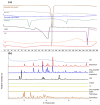Fabrication of Ciprofloxacin-Loaded Sodium Alginate Nanobeads Coated with Thiol-Anchored Chitosan Using B-390 Encapsulator Following Optimization by DoE
- PMID: 38931815
- PMCID: PMC11206434
- DOI: 10.3390/pharmaceutics16060691
Fabrication of Ciprofloxacin-Loaded Sodium Alginate Nanobeads Coated with Thiol-Anchored Chitosan Using B-390 Encapsulator Following Optimization by DoE
Abstract
Most infectious diseases of the gastrointestinal tract can easily be treated by exploiting the already available antibiotics with the change in administration approach and delivery system. Ciprofloxacin (CIP) is used as a drug of choice for many bacterial infections; however, long-term therapy and off-site drug accumulation lead to an increased risk of tendinitis and peripheral neuropathy. To overcome this issue, nanotechnology is being exploited to encapsulate antibiotics within polymeric structures, which not only facilitates dose maintenance at the infection site but also limits off-site side effects. Here, sodium alginate (SA) and thiol-anchored chitosan (TC) were used to encapsulate CIP via a calcium chloride (CaCl2) cross-linker. For this purpose, the B-390 encapsulator was employed in the preparation of nanobeads using a simple technique. The hydrogel-like sample was then freeze-dried, using trehalose or mannitol as a lyoprotectant, to obtain a fine dry powder. Design of Experiment (DoE) was utilized to optimize the nanobead production, in which the influence of different independent variables was studied for their outcome on the polydispersity index (PDI), particle size, zeta potential, and percentage encapsulation efficiency (% EE). In vitro dissolution studies were performed in simulated saliva fluid, simulated gastric fluid, and simulated intestinal fluid. Antibacterial and anti-inflammatory studies were also performed along with cytotoxicity profiling. By and large, the study presented positive outcomes, proving the advantage of using nanotechnology in fabricating new delivery approaches using already available antibiotics.
Keywords: B-390 encapsulator; anti-inflammatory; ionic gelation; nanobeads; sodium alginate; thiolated chitosan.
Conflict of interest statement
The authors declare no conflicts of interest.
Figures









Similar articles
-
Chitosan-Coated Azithromycin/Ciprofloxacin-Loaded Polycaprolactone Nanoparticles: A Characterization and Potency Study.Nanotechnol Sci Appl. 2023 Dec 21;16:59-72. doi: 10.2147/NSA.S438484. eCollection 2023. Nanotechnol Sci Appl. 2023. PMID: 38146545 Free PMC article.
-
Alginate coated chitosan core shell nanoparticles for oral delivery of enoxaparin: in vitro and in vivo assessment.Int J Pharm. 2013 Nov 1;456(1):31-40. doi: 10.1016/j.ijpharm.2013.08.037. Epub 2013 Aug 29. Int J Pharm. 2013. PMID: 23994363
-
Nanoencapsulation of saffron crocin into chitosan/alginate interpolyelectrolyte complexes for oral delivery: A Taguchi approach to design optimization.J Food Sci. 2022 Mar;87(3):1148-1160. doi: 10.1111/1750-3841.16052. Epub 2022 Feb 12. J Food Sci. 2022. PMID: 35150139
-
Chitosan-Coated Alginate Microcapsules Loaded with Herbal galactagogue Extract: Formulation Optimization and Characterization.Iran J Pharm Res. 2019 Summer;18(3):1180-1195. doi: 10.22037/ijpr.2019.1100776. Iran J Pharm Res. 2019. PMID: 32641931 Free PMC article.
-
Evaluation of chitosan/alginate beads using experimental design: formulation and in vitro characterization.AAPS PharmSciTech. 2010 Mar;11(1):460-6. doi: 10.1208/s12249-010-9406-z. Epub 2010 Mar 19. AAPS PharmSciTech. 2010. PMID: 20300894 Free PMC article. Review.
Cited by
-
Silk Fibroin-Alginate Aerogel Beads Produced by Supercritical CO2 Drying: A Dual-Function Conformable and Haemostatic Dressing.Gels. 2025 Aug 2;11(8):603. doi: 10.3390/gels11080603. Gels. 2025. PMID: 40868734 Free PMC article.
References
-
- Roberts C.A., Buikstra J.E. Ortner’s Identification of Pathological Conditions in Human Skeletal Remains. Elsevier; Amsterdam, The Netherlands: 2019. Bacterial infections; pp. 321–439.
LinkOut - more resources
Full Text Sources

